This guide is a simple guide to Google Search Console. If you are new to SEO, you will love this blog post because I have simply explained everything.
Plus, this will take only 7 minutes of your time to familiarize yourself with Google Search Console.
Let’s get started!
Guide To Google Search Console
What is Google Search Console?
A guide to Google Search Console is not complete without an introduction to GSC.
As you already know, Google offers us many valuable tools. Google Search Console is also a free tool offered by Google that is helpful for the owners of websites. You can clearly identify your website presence in Google Search Results using Google Search Console (GSC).
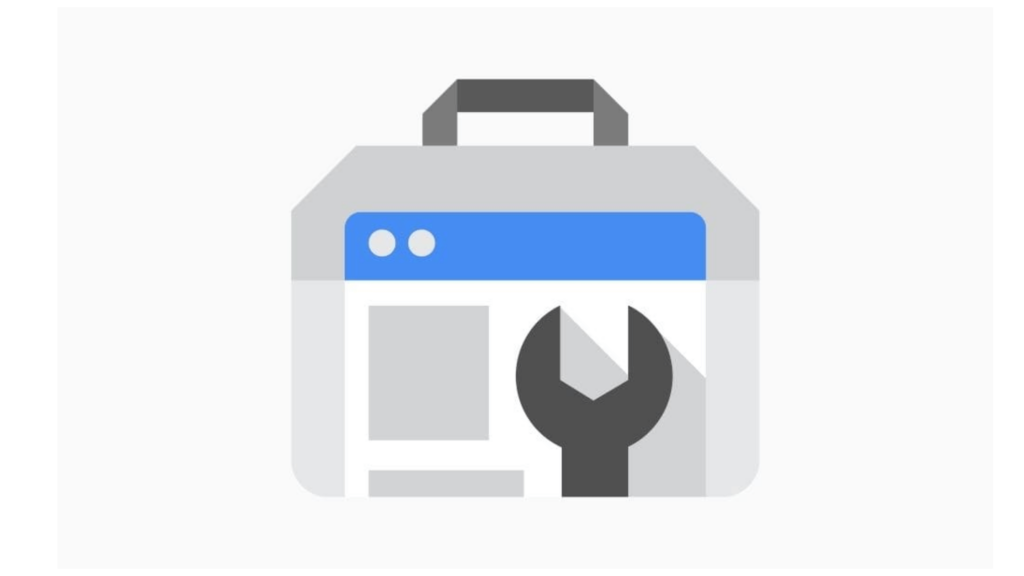
You can do the following with Google Search Console,
- Find & fix indexing issues.
- Request to re-index new or updated content.
- See whether Google can find & crawl your website.
- Check how often your website appears in Google Search.
- Check for which keywords your website shows up.
- Get alerts about indexing, spam, or other issues on your website.
- Check which sites link to your website.
- Troubleshoot issues related to mobile usability, AMP & other features.
Now we know what Google Search Console is & what you can do with it. But who exactly can use this platform???
The answer is Anyone with a website can use GCS. Business owners should have a clear idea about Google Search Console. They may not be using it. But it is good to have a basic knowledge.
SEO Specialists & marketers can use this to see the website traffic, get suggestions, and get better decisions about the site’s appearance. Your decision-making process will be more effective & successful.
Site administrators can use GSC to monitor the website & identify issues like loading issues, server errors & security issues.
This guide to Google Search Console will explain everything you need to know.
How to Add your website to Google Search Console:
Following are the steps on how to setup Google Search Console. You can do these to add your website to Google Search Console,
Step 1:
The first step is to sign into your Google Account. If you are adding your business website, you should sign into your business’s Google Account.
Step 2:
Go to Google Search Console & click “Add a property.”
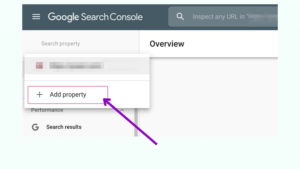
Step 3:
You will get a drop-down menu & select “Website” from it. Then enter your website URL into the domain field. You should enter the exact URL in the browser bar. Then click continue.
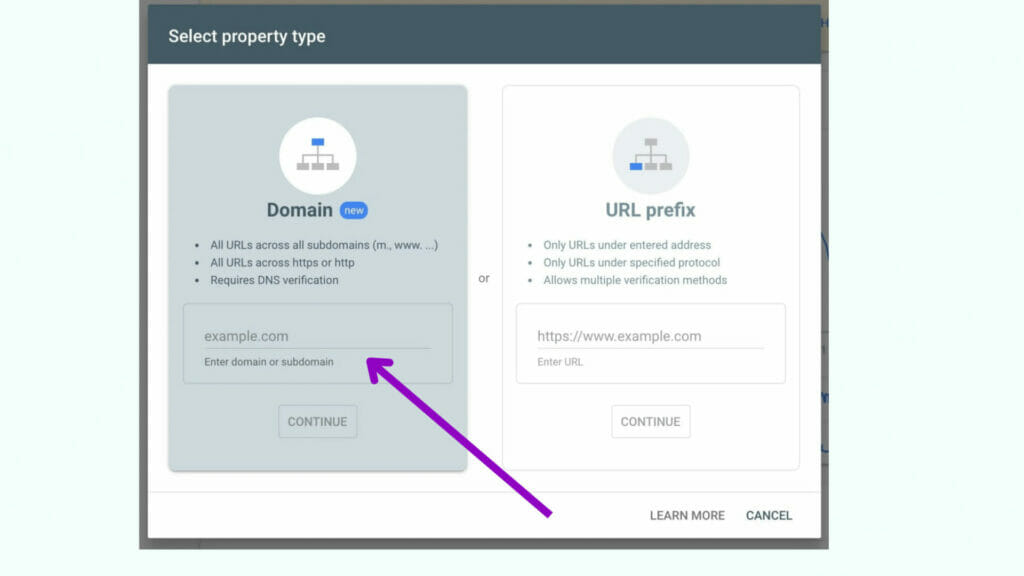
Step 4:
Then it’s time to verify that you own your website. This verification process is essential to get access to GSC.
When using GSC, you can access confidential information about a website’s performance. So, it is necessary to verify that the website belongs to you. Just because you are verified in GSC, doesn’t impact your ranking in search engines.
Following are the currently available verification methods,
1.HTML file uploading – You can upload a verification HTML file to a location on your website.
2.HTML tag – Adding a meta tag to the head section on a specific webpage HTML code.
3.Domain name provider- You can sign in to the domain registrar & then verify your website directly from GSC.
4.Google Analytics tracking code – Copy the Google Analytics tracking record.
5.Google Tag manager container snippet code- Copy the GTM container snippet code associated with your website.
Adding a Domain Property
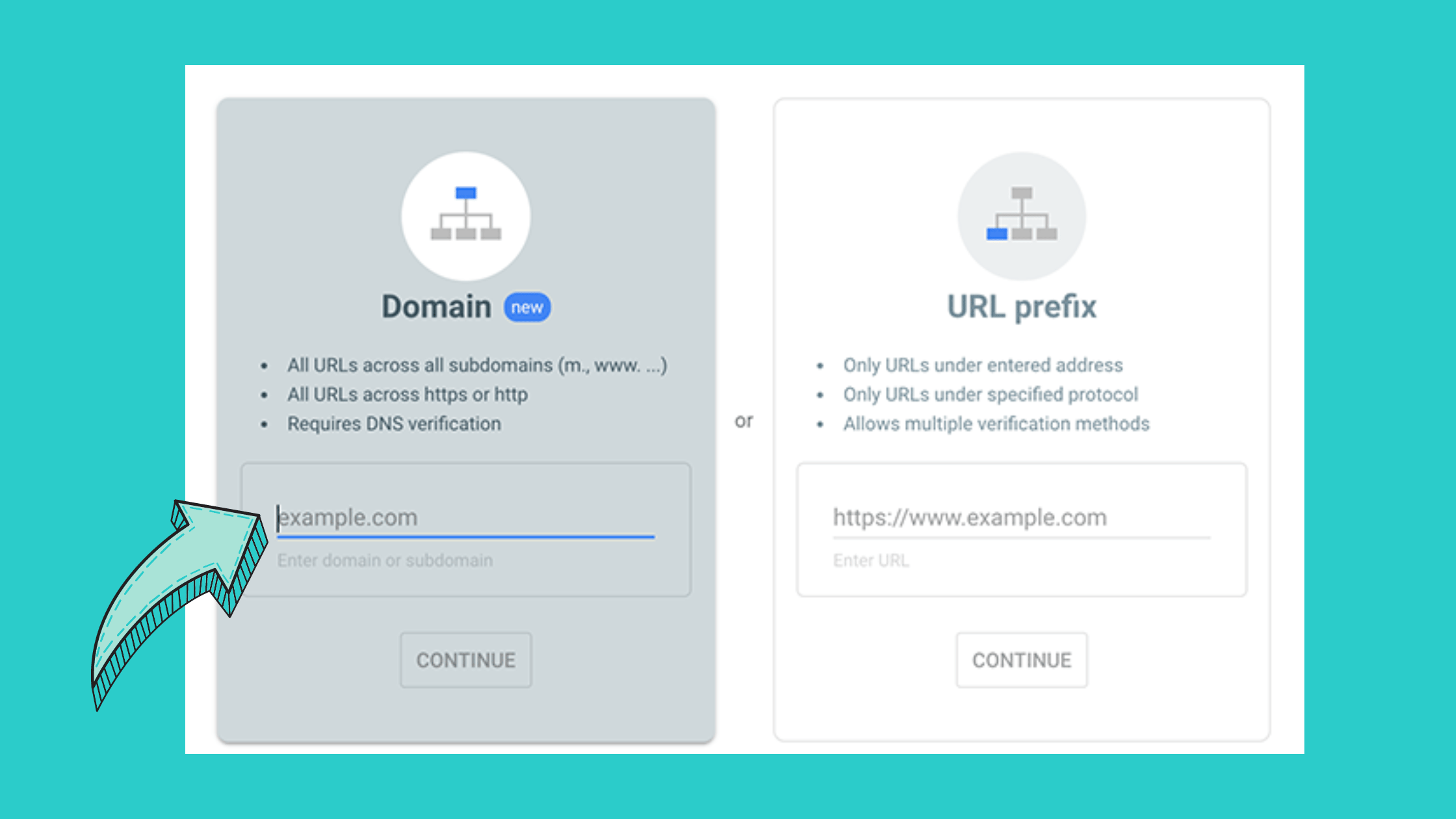
When you add a domain property, you get a comprehensive view of website information. This information includes all URLs under a domain name, subdomains, paths & protocols.
If you add a property using this method, you should verify through the Domain Name System provider.
How to do this?
- Click Search property & then click Add property.
- Add your domain without www/ HTTP/ HTTPS.
- For example, if your domain URL is https://digifix.com.au, you should enter digifix.com.au
- Then click Continue.
- You will get a pop-up window with a verification code & copy that code. Remember, you should not close this window.
- Then open a new tab & sign in to your account with your domain registrar.
- When you log in, access your DNS setting. For this, click the nine dots in the navigation bar & click Domains.
- In the Domain Portfolio dashboard, click 3 dots & click Edit DNS.
- Click Add to add a new TXT record.
- Then a pop-up will appear & fill the details like below,
Type: TXT
Name: @
Value: Paste the Verification code (TXT record) you copied before when verifying.
- Then click Add record.
- Then Go to Google Search Console & click Verify.
- At first there is a chance to get a message that says “Ownership Verification failed.” But don’t worry, because the verification process takes time. So, try again.
- Finally, you will get a confirmation message that indicates the success of your process.
Adding a URL prefix Property:
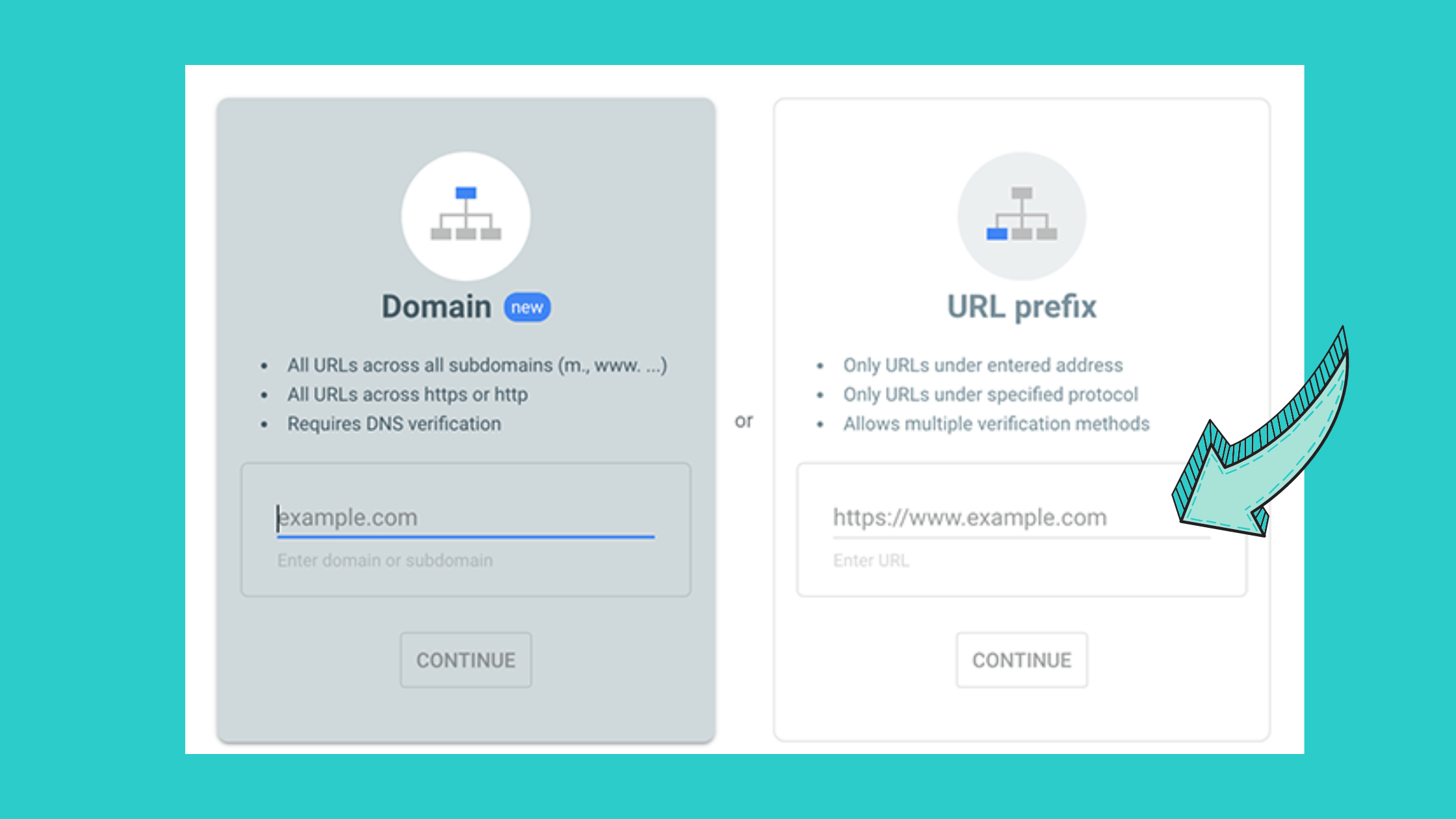
If you want to view data only about a specific section of your website, adding a URL prefix is the best option. For example, you can add your blog page.
How to do this?
- First, enter your URL in the URL prefix box.
- There are several verification methods.
- HTML file
- HTML tag
- Google Analytics
- Google Tag Manager
- Domain name provider
- Google recommends the HTML file method. So, let’s try that method. Click the HTML file option to expand it. Then you will see the file download option.
- Download your HTML verification file & upload it to the root directory. (It should be the website you want to verify).
- When you complete this, click Verify in the Search Console.
- This verification will take time.
Roles in Google Search Console:
Owners & Users & Associates in Google Search Console:
In Google Search Console, there are two types of roles. It is just like in your company. You have people that play different roles. Like that, in GSC, there are two roles: Owners & users.
Owner – An Owner has total control over the properties in Google Search Console. They have the power to add users & remove users, change settings in GSC, view all the data, & access any tool in GSC.
There are two types of owners like verified owners & delegated owners. A Verified owner is verified through the verification process. And the delegated owners are added by verified owners. And delegated owners can add other delegated owners.
When giving ownership, you should be very careful & think more.
Users –
Users can see all the data & also take a few actions. But they have no power to add new users.
There are two types of users: Full users & restricted users. Full users can see a considerable amount of data & take action. Restricted users only can see most data & can’t take action.
Associates-
People or accounts that are able to take some actions for your website. Or else associates have the ability to access some data. They can’t open your GSC account directly or view data directly.
Managing roles in Google Search Console:
In GSC, there can be a maximum of 100 users/owners. Only a property owner can add or remove another user.
Adding a new user / delegated owner:
- Select a property in your Search Console.
- Click the setting icon in the navigation pane.
3.Click USERS & PERMISSIONS.
- Click Add user.
- Type the Google account name of the new user.
- Select which role (permission level) you want to give that user.
- Finally, save the changes you made.
Delete a user/delegated owner:
- Select a property in your Google Search Console.
- Click the setting icon in the navigation pane.
- Click users & permissions.
- Select the menu next to the user to delete & click REMOVE ACCESS.
Identify Technical SEO issues with Google Search Console:
In Google Search Console, there are different opportunities for you to identify & fix Technical SEO issues.
1.Index Coverage Report
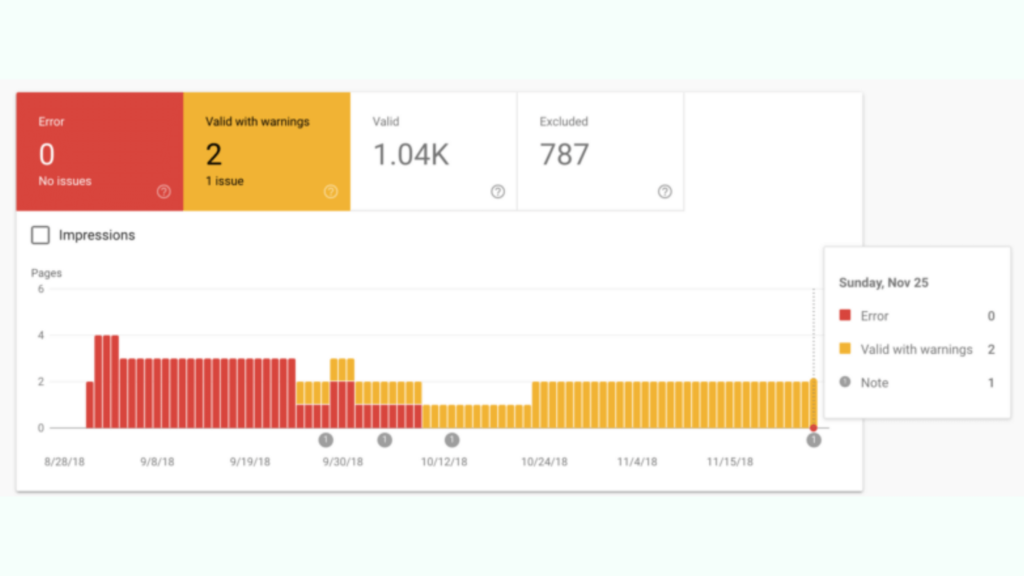
Index Coverage report informs you about technical issues that prevent your website from getting crawled & indexed. As a good practice, you should check this report regularly. It will help to find & fix technical SEO issues.
Google introduced the Index Coverage report in 2018. In January 2021, Google made some improvements to this report to provide more precise & clear insights.
This report shows the technical SEO issues that prevent your website from getting indexed.
How to get Index Coverage report:
- Log into Google Search Console Account.
- There is a menu on the left & select “Coverage” from it.
- You can select a status you want to see on the report. There are four statuses :Error, valid with warnings, valid & excluded.
Error
In this section you can see crawling & indexing issues you should pay attention to. If you see 50 under errors, that means there are 50 errors on your website. Then scroll down to see the reasons for those errors.
I will list down some of the errors you will see,
- Redirect errors
- The submitted URL has crawl issues
- Server errors
- Submitted URL not found
Issues with “Submitted” are the URLs that have been submitted for indexing. When you submit a site map with URLs, Google will discover them. Make sure to add URLs that you want to be indexed, when you are submitting a site map.
Following are some errors you will find in the error section:
Server error- These are the server errors with 5xx codes. For example, 503 services are unavailable. Google bots have to face troubles when indexing pages with server errors. So, you should monitor those pages regularly.
Redirect errors-
A redirect transfers search engine crawlers & users from old URLs to new ones. Redirects usually happen when the old URL is changed or the content is not there anymore.
Redirect errors point to the following problems:
Submitted URL blocked by robot.txt-
The URLs in this section are submitted in a sitemap but they are blocked in robot.txt. A robot.txt is a file with instructions for robots to crawl your website.
Submitted URL marked as no index-
These URLs are submitted through a site map but blocked by a noindex tag. This no index tag prevents the crawlers from indexing your website. If you need to index your website, you should remove the no index tag.
The submitted URL is a soft 404-
Sof 404 means that a page returns 200 OK status but its content makes it look like an error.
Valid with warnings
These URLs are indexed by Google but have some less critical issues.
Valid
You have nothing to worry about these URLs. These URLs are correctly indexed by Google.
Excluded
These pages have not been indexed by Google due to issues within them. You should immediately pay attention to these pages.
Two types of pages in the Index coverage report:
There are two types of pages in the Index Coverage report: All submitted pages & All known pages. As a default, it shows all known pages. Here it displays the URLs discovered by Google. All submitted pages include the URLs submitted in a sitemap.
Regularly checking the Index Coverage report will help to find & fix crawling & indexing issues. Try to check this report at least once a week.
Attention business owners!
Are you ready to take your company to the next level and reach new heights of success? Look no further than DigiFix, your one-stop-shop for all your digital marketing needs!
Don’t wait any longer to transform your business! Contact DigiFix today and take the first step towards achieving your goals. We’re confident that with our help, you’ll see measurable results and experience unprecedented growth
2.Performance Report.
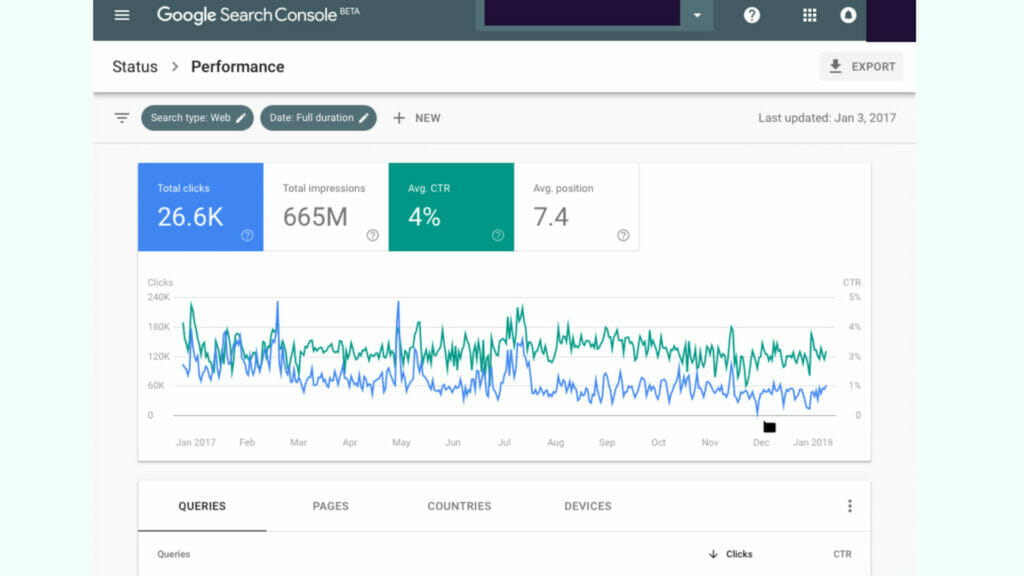
Previously I explained about index coverage report. Now I am going to explain about the Performance report.
Google Search Console offers you a performance report which displays your website’s overall search performance on Google. The performance report in GSC displays insights about search results & discovery. Search results overview shows total clicks, total impressions, average CTR & average position.
You can filter this information according to pages, countries, devices, dates & queries.
Discover overview is similar to search results but does not filter by queries, devices & pages.
On the old version of Search Console (Google Webmaster Tools), there wasn’t a performance report. Instead, it had a search analytics report.
In the old version, you only could view search data within the last 90 days. But in the new version, you can view 16 months of data.
Pretty cool, isn’t it?
How to get the Performance Report in Google Search Console:
- Go to Google Search Console.
- Click OVERVIEW.
- Click Open Report under the overview.
- Then, you will get the performance report.
Insights on Performance Report:
Clicks
Total Clicks are how many times a user clicks through to your website. With more clicks, you get better search traffic..
Impressions
The number of times a user saw a link to your website in search results is known as total impressions. If the result was scrolled into view, a different calculation is made for photos and other search result kinds.
CTR
Click Through Rate is referred to as CTR. Searchers are clicking through to your website at this pace. You can get this value by multiplying the result of the clicks/impressions ratio by 100.
Clicks/impressions*100=CTR
A search result that has a high CTR is being clicked on by more users. It denotes that the search result matches the keyword used and is likely to appear on Google’s first page of results.
Position
The position is based on the average position for a specific keyword or URL for the chosen period. The average position is a trustworthy metric to utilize because positions can vary significantly. This enables you to determine whether something is occurring or whether there has been a change.
Conclusion
There are many tools you can use for search engine optimization. Some tools are free & for some, we have to pay. If you own a website, you can’t ignore SEO because SEO helps to increase your search engine rankings.
So, in this blog post, I have explained a free tool offered by Google to help with our SEO. I hope at the end of the blog, you have increased your knowledge about Google Search Console.
Use Google Search Console properly & get a higher ranking on Search Engines.
If you need any digital marketing related service, our team at DigiFix is more than happy to help you. Visit our DigiFix website to contact us.
You may like the following blog articles as well,
Do you want more traffic?
—————
Hi, we are an Australian digital agency doing groundbreaking work to help a business like yours reach its full potential. My only question is will you qualify for our services?
Do you want more traffic?
—————
Hi, we are an Australian digital agency doing groundbreaking work to help a business like yours reach its full potential. My only question is will you qualify for our services?





0 Comments